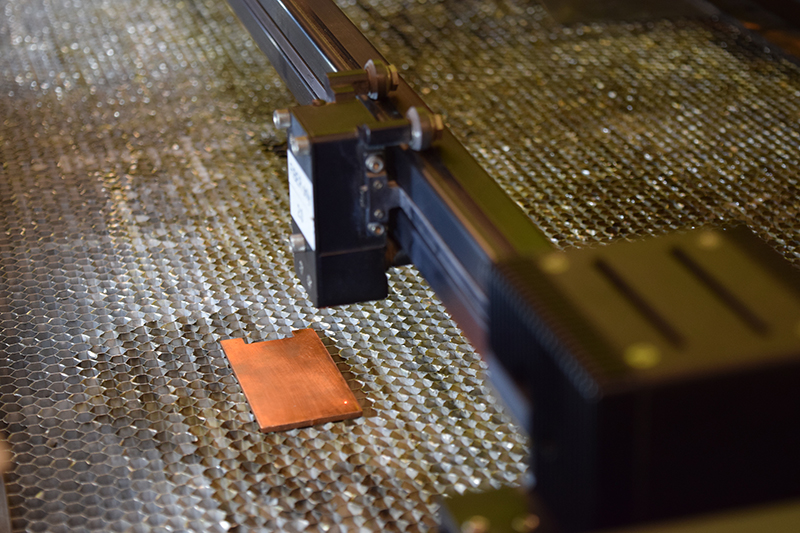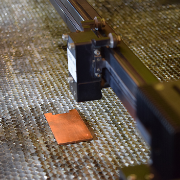WEST LAFAYETTE, Ind. — Bacterial pathogens can live on surfaces for days. What if frequently touched surfaces such as doorknobs could instantly kill them off?
Purdue University engineers have created a laser treatment method that could potentially turn any metal surface into a rapid bacteria killer – just by giving the metal’s surface a different texture.
In a study published in the journal Advanced Materials Interfaces, the researchers demonstrated that this technique allows the surface of copper to immediately kill off superbugs such as MRSA.
“Copper has been used as an antimicrobial material for centuries. But it typically takes hours for native copper surfaces to kill off bacteria,” said Rahim Rahimi, a Purdue assistant professor of materials engineering.
“We developed a one-step laser-texturing technique that effectively enhances the bacteria-killing properties of copper’s surface.”
The technique is not yet tailored to killing viruses such as the one responsible for the COVID-19 pandemic, which are much smaller than bacteria.
Since publishing this work, however, Rahimi’s team has begun testing this technology on the surfaces of other metals and polymers that are used to reduce risks of bacterial growth and biofilm formation on devices such as orthopedic implants or wearable patches for chronic wounds.
Giving implants an antimicrobial surface would prevent the spread of infection and antibiotic resistance, Rahimi said, because there wouldn’t be a need for antibiotics to kill off bacteria from an implant’s surface.
The technique might apply to metallic alloys that also are known to have antimicrobial properties.
Metals such as copper normally have a really smooth surface, which makes it difficult for the metal to kill bacteria by contact.
The technique developed by Rahimi’s team uses a laser to create nanoscale patterns on the metal’s surface. The patterns produce a rugged texture that increases surface area, allowing more opportunity for bacteria to hit the surface and rupture on the spot. A YouTube video is available at https://youtu.be/3vFFdNXsoN0.
Researchers in the past have used various nanomaterial coatings to enhance the antimicrobial properties of metal surfaces, but these coatings are prone to leach off and can be toxic to the environment.

“We’ve created a robust process that selectively generates micron and nanoscale patterns directly onto the targeted surface without altering the bulk of the copper material,” said Rahimi, whose lab develops innovative materials and biomedical devices to address health care challenges.
The laser-texturing has a dual effect: The technique not only improves direct contact, but also makes a surface more hydrophilic. For orthopedic implants, such a surface allows bone cells to more strongly attach, improving how well the implant integrates with bone. Rahimi’s team observed this effect with fibroblast cells.
Due to the simplicity and scalability of the technique, the researchers believe that it could easily be translated into existing medical device manufacturing processes.
The work was funded in part by Purdue’s School of Materials Engineering and the Wabash Heartland Innovation Network. This research was performed at the Birck Nanotechnology Center in Purdue’s Discovery Park.
About Discovery Park
Discovery Park is a place where Purdue researchers move beyond traditional boundaries, collaborating across disciplines and with policymakers and business leaders to create solutions for a better world. Grand challenges of global health, global conflict and security, and those that lie at the nexus of sustainable energy, world food supply, water and the environment are the focus of researchers in Discovery Park. The translation of discovery to impact is integrated into the fabric of Discovery Park through entrepreneurship programs and partnerships.
About Purdue University
Purdue University is a top public research institution developing practical solutions to today’s toughest challenges. Ranked the No. 6 Most Innovative University in the United States by U.S. News & World Report, Purdue delivers world-changing research and out-of-this-world discovery. Committed to hands-on and online, real-world learning, Purdue offers a transformative education to all. Committed to affordability and accessibility, Purdue has frozen tuition and most fees at 2012-13 levels, enabling more students than ever to graduate debt-free. See how Purdue never stops in the persistent pursuit of the next giant leap at purdue.edu.
Writer: Kayla Wiles, Working remotely but will provide immediate response.
Source: Rahim Rahimi, Available for phone and Skype interviews.
The paper is available online open-access. B-roll and additional photos of a new technique that enhances the antimicrobial properties of copper are available in a Google Drive folder at https://purdue.university/2wPqYon. A YouTube video is also available at https://youtu.be/3vFFdNXsoN0.
ABSTRACT
Hierarchical Micro/Mesoporous Copper Structure with Enhanced Antimicrobial Property via Laser Surface Texturing
Vidhya Selvamani, Amin Zareei, Ahmed Elkashif, Murali Kannan Maruthamuthu, Shirisha Chittiboyina, Davide Delisi, Zheng Li, Lirong Cai, Vilas G. Pol, Mohamed N. Seleem, and Rahim Rahimi
Purdue University, West Lafayette, IN, USA
DOI: 10.1002/admi.201901890
Copper (Cu) and its alloys have been shown to eradicate a wide range of multidrug‐resistant microbes upon direct contact. In this study, a facile one‐step laser texturing (LT) process is demonstrated to effectively enhance the bactericidal properties of copper surfaces via concurrent selective modification of surface topography and chemistry of laser textured copper (LT‐Cu). Surface morphology and elemental composition are analyzed via field emission scanning electron microscopy (FE‐SEM), energy‐dispersive X‐ray spectroscopy (EDX), and Raman spectroscopy. Surface area and pore size of LT‐Cu is determined by Barrett–Joyner–Halenda (BJH) and Brunauer–Emmett–Teller (BET) analysis. It reveals direct formation of mesoporous structures with higher surface oxide (Cu2O and CuO), which provide a highly stable superhydrophilic property to the LT‐Cu surfaces. The antibacterial properties of LT‐Cu are tested against pathogenic bacterial strains with different concentrations including Pseudomonas aeruginosa, and methicillin‐resistant Staphylococcus aureus (MRSA USA300) at 105 CFU mL−1, and Escherichia coli and Staphylococcus aureus at high bacterial concentrations of 108 CFU mL−1 using standard contact killing tests. The analysis shows that LT‐Cu needs 40, 90, 60, and 120 min to completely eradicate the respective bacterial strain. The LT‐Cu causes membrane damage to the bacterial cells immediately after exposure. Furthermore, the biocompatibility of LT‐Cu is investigated by in vitro immune‐staining assays with mammary stromal fibroblasts and T4‐2 cells.
この情報へのアクセスはメンバーに限定されています。ログインしてください。メンバー登録は下記リンクをクリックしてください。

